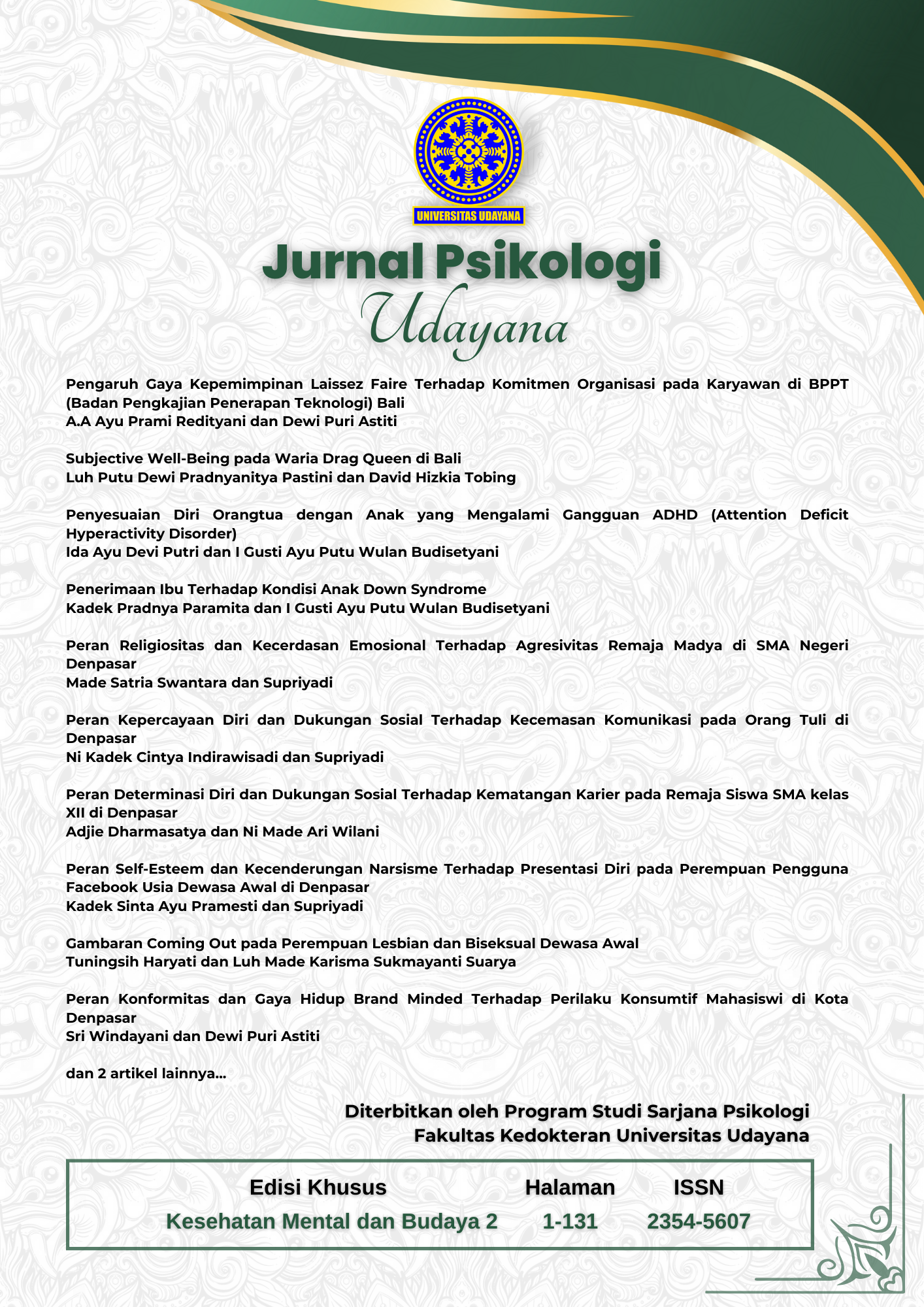Gambaran coming out pada perempuan lesbian dan biseksual dewasa awal
Abstract
Lesbian, Gay, Biseksual, dan Transgender (LGBT) kerap dipandang sebagai suatu penyakit sosial di masyarakat, karena dianggap melanggar nilai dan norma yang dianut oleh masyarakat Indonesia. Di sisi lain, kelompok LGBT yang telah menjadi dewasa awal membutuhkan coming out untuk memenuhi tugas perkembangannya, sehingga menimbulkan konflik tersendiri. Penelitian ini menggunakan pendekatan kualitatif dengan metode studi kasus. Kriteria responden penelitian ini adalah perempuan, lesbian atau biseksual, berusia 18-30 tahun, dan belum menikah. Melalui analisis koding, ditemukan beberapa hal yang menggambarkan coming out, seperti awal mula menyadari orientasi seksual, hubungan berpacaran yang pernah dijalani, opini mengenai orientasi seksual, coming out menurut responden, cara melakukan coming out, orang-orang yang telah mengetahui orientasi seksual para responden, coming out dan kaitannya dengan agama, tujuan melakukan coming out, dampak positif dan dampak negatif yang dirasakan karena melakukan coming out, prioritas kedepannya untuk melakukan coming out, kriteria target coming out, pandangan responden terhadap kemungkinan coming out di lingkungannya, orang yang menginspirasi responden untuk coming out, tiga kata yang menggambarkan proses coming out, harapan kedepannya, pandangan responden mengenai penelitian ini, serta coming out dan intimasi. Penelitian ini diharapkan dapat memberikan informasi mengenai coming out, khususnya pada perempuan lesbian dan biseksual, dan mengurangi stigma terhadap lesbian dan biseksual.
Downloads
References
American Psychological Association. (2008). Answers to your questions for a better understanding of sexual orientation & homosexuality. Washington, DC: American Psychological Association
Balsam, K. F., & Mohr, J. J. (2007). Adaptation to sexual orientation stigma: A comparison of bisexual and lesbian/gay adults. Journal of Counseling Psychology, 54(3), 306–319. doi:10.1037/0022-0167.54.3.306
Bancroft, J. (2009). Human sexuality and it’s problems third edition. London: Churchill Livingstone Elsevier
Batool, S., & Malik, N. I. (2010). Role of attitude similarity and proximity in interpersonal attraction among friends (C 310). International Journal of Innovation, Management and Technology, 1(2), 142-146. ISSN:2010-0248
Ben-Ari, A. (1995). The discovery that an offspring is gay: Parents’, gay men’s, and lesbians’ perspectives. Journal of Homosexuality, 30, 89–112. doi: 10.1300/J082v30n01_05
Bohan, J. S. (1996). Psychology and sexual orientation: Coming to terms. New York: Routledge
Cooper, L. (2008). On the other side: Supporting sexual minority students. British Journal of Guidance & Counselling, 36(4), 425–440. doi:10.1080/03069880802364577
Cramer, D. W., & Roach, A. J. (1988). Coming out to Mom and Dad: A study of gay males and their relationships with their parents. Journal of Homosexuality, 15, 79–91. doi: 10.1300/J082v15n03_04
Crocker, J., Major, B., & Steele, C. (1998). Social stigma. In D. Gilbert & S. Fiske (Eds.), Handbook of Social Psychology (Vol. 2, 4th ed., pp. 504–551). New York: McGraw Hill
D’Augelli, A. R. (2002). Mental health problems among lesbian, gay, and bisexual youths ages 14 to 21. Clinical Child Psychology and Psychiatry, 7, 433–456. doi:10.1177/1359104502007003039
D’Augelli, A. R. (2006). Developmental and contextual factors and mental health among lesbian, gay, and bisexual youths. In A. M. Omoto & H. S. Kurtzman (Eds.), Sexual orientation and mental health: Examining identity and development in lesbian, gay, and bisexual people (pp. 37–53). Washington, DC: American Psychological Association
D’Augelli, A. R., Grossman, A. H., & Starks, M. T. (2005). Parents’ awareness of lesbian, gay, and bisexual youths’ sexual orientation. Journal of Marriage and Family, 67, 474–482. doi:10.1111/j.0022-2445.2005.00129.x
D’Augelli, A. R., Hershberger, S. L., & Pilkington, N. W. (1998). Lesbian, gay, and bisexual youth and their families: Disclosure of sexual orientation and its consequences. American Journal of Orthopsychiatry, 68, 361–371. doi:10.1037/h0080345
D’Augelli, A.R. & Patterson, C. J. (1995). Lesbian, gay, and bisexual identities over the lifespan: Psychological perspectives. New York: Oxford University Press
Dermer, S. B., Smith, S. D., & Barto, K. K. (2010). Identifying and correctly labeling sexual prejudice, discrimination, and oppression. Journal of Counseling & Development, 88, 325–331. doi:10.1002/j.1556-6678.2010.tb00029.x
Faulkner, A. H., & Cranston, K. (1998). Correlates of same-sex sexual behavior in a random sample of Massachusetts high school students. American Journal of Public Health, 88, 262–266. doi:10.2105/AJPH.88.2.262
Feist, J., & Feist, G. J. (2010). Theories of personality. Dubuque: McGraw-Hill Education
Haryati, T. (2018). Studi pendahuluan: Mengapa seorang perempuan biseksual tidak melakukan coming out pada keluarga?.. Naskah tidak dipublikasikan, Program Studi Psikologi Fakultas Kedokteran, Universitas Udayana Denpasar.
Haryati, T., Ritawari, I. G. A. K., Lestari, M. D. & Wilani, N. M. A. (2017). Proses Pengambilan Keputusan Partial Coming Out pada Perempuan Biseksual. Proceedings Temu Ilmiah Nasional Psikologi 11th Psychofest. 461-477. ISBN: 978-682-71718-6-2
Herek, G. M. (2000). The psychology of sexual prejudice. Current Directions in Psychological Science, 9, 19–22. doi:10.1111/1467-8721.00051
Rohmitriasih, M. (2019). Mengenal Ciri-ciri Anak Berkebutuhan Khusus, Waspadai Sahabat Fimela. Diunduh dari https://www.fimela.com/parenting/read/3862189/mengenal-ciri-ciri-anak-berkebutuhan-khusus-waspadai-sahabat-fimela. Diakses tanggal 7 Juli 2019
Israel, T., & Selvidge, M. (2003). Contributions of multicultural counseling to counselor competence with lesbian, gay, and bisexual clients. Journal of Multicultural Counseling and Development, 31(2), 84–98. doi:10.1002/j.2161-1912.2003.tb00535.x
Knous, H. (2005). The coming out experience for bisexuals: Identity formation and stigma management. Journal of Bisexuality, 5(4), 37–59. doi:10.1300/J159v05n04_05
Kurdek, L. A. (1988). Perceived social support in gays and lesbians in cohabitating relationships. Journal of Personality and Social Psychology, 54(3), 504–509. doi: 10.1037/0022-3514.54.3.504
Lehmiller, J. J. (2014a). Psychology of human sexuality. S.L.: Wiley-Blackwell
Mayfield, W. (2001). The development of an internalized homonegativity inventory for gay men. Journal of Homosexuality, 41, 53–76. doi:10.1300/J082v41n02_04
Mays, V. M., & Cochran, S. D. (2001). Mental health correlates of perceived discrimination among lesbian, gay, and bisexual adults in the United States. American Journal of Public Health, 91, 1869–1876. doi:10.2105/AJPH.91.11.1869
McLean, K. (2007). Hiding in the closet? Bisexuals, coming out and the disclosure imperative. Journal of Sociology, 43(2), 151–166. doi:10.1177/1440783307076893
McLean, K. (2008). Inside, outside, nowhere: Bisexual men and women in the gay and lesbian community. Journal of Bisexuality, 8(1-2), 63–80. doi: 10.1080/15299710802143174
Mitteness, C. R., DeJordy, R., Ahuja, M. K., & Sudek, R. (2014). Extending the role of similarity attraction in friendship and advice networks in angel groups. Entrepreneurship Theory and Practice, 40(3), 627-655. doi:10.1111/etap.12135
Moleong, L. J. (2016). Metodologi penelitian kualitatif (edisi revisi). Bandung: PT. Remaja Rosdakarya
Murphy, B.C. (1989). Lesbian couples and their parents: The effects of perceived parental attitudes on the couple. Journal of Counseling and Development, 68, 46–51. doi: 10.1002/j.1556-6676.1989.tb02492.x
Murr, R. (2013) ‘I became proud of being gay and proud of being Christian’: The spiritual journeys of queer Christian women. Journal of Religion & Spirituality in Social Work: Social Thought, 32(4), 349–372. doi:10.1080/15426432.2013. 839241
Nardi, P. M., & Sherrod, D. (1994). Friendship in the lives of gay men and lesbians. Journal of Social and Personal Relationships, 11, 185–199. doi: 10.1177/0265407594112002
Nisaa, C., Pitayanti, A., & Hani, I. M. (2016). Correlation between of social support with self concept on the Sidoarjo’s LGBT community (Research of Sidoarjo’s LGBT Community). Jurnal Keperawatan, 5(1). Retrieved from http://digilib.stikesicmejbg.ac.id/ojs/index.php/jip/article/view/86
O’Brien, J. (2017, December 6). The dangers of homophobia. Retrieved from https://www.psychologytoday.com/intl/blog/all-things-lgbtq/201712/the-dangers-homophobia
Pistella, J., Salvati, M., Ioverno, S., Laghi, F., & Baiocco, R. (2016). Coming-out to family members and internalized sexual stigma in bisexual, lesbian and gay people. Journal of Child and Families Studies, 25, 3694-3701. doi:10.1007/s10826-016-0528-0
Rasmussen, M. L. (2004). The problem of coming out. Theory Into Practice, 43(2), 144-150. doi: 10.1353/tip.2004.0025
Rodriguez, E. M. (2009). At the intersection of church and gay: A review of the psychological research on gay and lesbian Christians. Journal of Homosexuality, 57(1), 5–38. doi:10.1080/00918360903445806
Rosario, M., Hunter, J., Maguen, S., Gwadz, M., & Smith, R. (2001). The coming-out process and its adaptational and health-related associations among gay, lesbian, and bisexual youths: Stipulation and exploration of a model. American Journal of Community Psychology, 29(1), 133–160. doi:10.1023/A:1005205630978
Ryan, C. (2009). Supportive families, healthy children: Helping families with lesbian, gay, bisexual & transgender children. San Francisco: Marian Wright Edelman Institute, San Francisco State University
Ryan, C., Huebner, D., Diaz, R. M., & Sanchez, J. (2009). Family rejection as a predictor of negative health outcomes in white and Latino lesbian, gay, and bisexual young adults. Pediatrics, 123, 346–352. doi:10.1542/peds.2007-3524
Ryan, W. S., Legate, N., & Weinstein, N. (2015). Coming out as lesbian, gay, or bisexual: the lasting impact of initial disclosure experiences. Self and Identity, 14(5), 549-569. doi:10.1080/15298868.2015.1029516
Santrock, J. W. (2011). Life-span development 13th edition. New York: McGraw-Hill
Savin-Williams, R. C. (1998b). The disclosure to families of same-sex attractions by lesbian, gay, and bisexual youths. Journal of Research on Adolescence, 8, 49–68. doi:10.1207/s15327795jra0801_3
Savin-Williams, R. C. (2003). Lesbian, gay and bisexual youths’ relationships with their parents. In L. D. Garnets & D. C. Kimmel (Eds.), Psychological perspectives on lesbian, gay, and bisexual experiences (2nd ed., pp. 299–326). New York: Columbia University Press
Septian, A., Nugraha, C., Imran. (2018, Februari). Nasib wadam di tahun politik. Tempo, 4458, 30-35
Staf. (2019). Arti istilah jeruk makan jeruk menurut KBBI. Retrieved from https://apaarti.com/arti-istilah/jeruk-makan-jeruk.html
Strauss, A., & Corbin, J. (1990). Basics of qualitative research: grounded theory procedures and techniques. California: Sage Publications, Inc.
Subhi, N., & Geelan, D. (2012). When Christianity and homosexuality collide: Understanding the potential intrapersonal conflict. Journal of Homosexuality, 59(10), 1382–1402. doi:10.1080/00918369.2012.724638
Sugiyono. (2016). Metode penelitian kombinasi (mix methods). Bandung: Alfabeta
Unknown. (n.d.). Kumpulan Seratus Peribahasa dan Artinya. Retrieved from https://www.ilmubahasa.net/2015/05/peribahasa.html
Wandrey, R. L., Mosack, K. E., & Moore, E. M. (2015). Coming out to family and friends as bisexually identified young adult women: A discussion of homophobia, biphobia, and heteronormativity. Journal of Bisexuality, 15(2), 204–229. doi: 10.1080/15299716.2015.1018657
Authors who publish with this journal agree to the following terms:
- Authors retain copyright and grant the journal right of first publication with the work simultaneously licensed under a Creative Commons Attribution-ShareAlike 4.0 International License that allows others to share the work with an acknowledgement of the works authorship and initial publication in this journal.
- Authors are able to enter into separate, additional contractual arrangements for the non-exclusive distribution of the journals published version of the work (e.g., post it to an institutional repository or publish it in a book), with an acknowledgement of its initial publication in this journal.
- Authors are permitted and encouraged to post their work online (e.g., in institutional repositories or on their website) prior to and during the submission process, as it can lead to productive exchanges, as well as earlier and greater citation of published work (See The Effect of Open Access).













